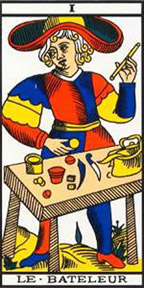Sor(tri)lège: Trio III (2007)
for Violin, Cello and Piano
Duration: 20 minutes
Commissioned by the University of Texas at Dallas for the Clavier Trio
Arkady Fomin, Violin; Jesús Castro-Balbi, Cello; David Korevaar, Piano
Premiere Performance: February 8, 2007; University of Texas at Dallas
New York Premiere: February 10, 2007; Weill Hall at Carnegie Hall
Le Bateleur (The Magician) from
the Tarot of Marseilles

Reviews:
A feeling of magic and illusion pervades Sor(tri)lège: Trio III… The opening Incantation casts an airy spell, full of muted light and fleeting shadows. The instrumental interplay through Magie de Cabaret echoes the jagged, jangly style of Kurt Weill. The final Charme de Trois is restless and mysterious, its climbing melodies billowing like curling smoke.
Chris Shull, Fort Worth Star-Telegram
…This memorable work has intricate instrumental interplay and soaring, inspired melodies that keep listeners involved. The music was sometimes dance-like with Latin-American flavoring; good news for contemporary music: the audience member next to me was smiling and tapping her foot throughout most of the performance. But the music’s accessibility is not at the expense of solid craftsmanship. Clavier Trio played it with impressive virtuosity, enormous dedication and joy. One should hope to see this work appear regularly.
Anthony Aibel, New York Concert Review
…substantial…effusive and joyous…the outer movements are splendid, arching out in vaulting melodic lines and enlivened with striking and unpredictable timbral combinations, urgent forward drive, and fresh, life-affirming ardor…could truly be described without condescension or apology as “modern romantic.”
Lehman, American Record Guide
Composer’s Note:
Sor(tri)lège: Trio III for Violin, Cello and Piano (2007) was commissioned by the University of Texas at Dallas School of Arts and Humanities, Dennis M. Kratz, Dean, for the Clavier Trio (violinist Arkady Fomin, cellist Jesús Castro-Balbi and pianist David Korevaar), who gave the premiere performances in February, 2008, both at UT-Dallas and at Carnegie Hall. Since my first two piano trios (1969-1971) date from my student days with Nadia Boulanger in Fontainebleau and Paris, this third trio marks a return to the genre after an absence of some thirty-seven years.
The title Sor(tri)lège combines the French word for sorcery, sortilège, with the number three to create a fanciful new word meaning “Sorcery for Three,” or, literally, “Sorcer(three).” The colorful aura of magic is an important element in the music, even from the very first notes: a mysterious descending three-fold phrase to represent three sweeps of a sorcerer’s wand: “One, Two…THREE!” In keeping with the world of magic, the virtuoso instrumental writing requires that all three players have the highest rank of technical wizardry.
The melodic content of the trio is developed from the two-voice opening “One, Two…THREE!” motive and two motives which follow. The harmonies are drawn from a short quasi-tonal chord sequence which moves upwards by minor thirds over an octatonic scale. Each movement carries the sequence through four keys before the opening key “magically” reemerges: I – Eb,Gb,A,C,(Eb); II – E,G,Bb,Db,(E); III – D,F,Ab,Cb,(D). Since each movement inhabits four different pitch areas, the three movements as a whole create a large-scale harmonic sweep, encompassing, in turn, each of the twelve tones. These melodic and harmonic materials reappear throughout, disguised in a variety of rhythmic variations.
The opening Incantation is cast in sonata-allegro form, with rich, lyrical intertwining among the three instruments. The “magic” harmonic cycle evolves slowly throughout the movement, with a reprise of the opening phrase at the midpoint, a tritone away, and a more forceful restatement at the climactic return, decorated with splashes of colorful harmonics in both strings and piano.
The second movement, Magie de Cabaret, has the French name for the type of magic performed, not on stage, but in a cabaret, with a magician moving from table to table to perform tricks. The music creates a cabaret atmosphere (more from Kurt Weill’s Berlin than from Edith Piaf’s Paris), as a playful little march moves deviously through the harmonic sequence, using several irregular meters. Midway, the magician pauses for an affettuoso interlude, perhaps to linger at the table of a particularly attractive member of the audience; then the march continues, stopping, from time to time, for a seductive look back.
The title of the last movement, Charme de Trois, literally “Charm of Three,” refers to the popular idea in many cultures that, as we say in English, “Third time’s the charm.” After a short cello introduction, a multi-layered musical spell is cast, as the strings begin an espressivo modulating canon in duple meter while the piano plays a pair of contrasting canons in triple meter over a shifting pedal point. The tempo gradually increases, and a brilliant toccata ensues, in which the strings and piano continue their two-against-three rhythmic conflict. As in the first movement, the chord sequence moves slowly through its harmonic journey. Toward the end of the toccata, however, there is a quiet moment as the secret of the harmonies is revealed: the chords can move, not only slowly, but extremely rapidly, and they can appear, not only by themselves, but combined with each other and in sharp juxtapositions. After this “discovery,” the major themes reappear in new, richer harmonizations as the toccata returns, and the trio ends with a flourish.